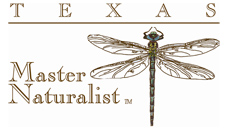The Hill Country Chapter of the Texas Master Naturalists are now accepting applications for the class of 2016. The mission of the Texas Master Naturalist program is to develop a corps of well-informed volunteers to provide education, outreach, and service dedicated to the beneficial management of natural resources and natural areas within their communities for the State of Texas.
Why become a Texas Master Naturalist?
 This year’s 2016 Class Director Diana Armbrust shares her transformation and learning curve from managing a manicured Houston home with St Augustine grass to living on some Hill Country property with native grasses, plants and trees.
This year’s 2016 Class Director Diana Armbrust shares her transformation and learning curve from managing a manicured Houston home with St Augustine grass to living on some Hill Country property with native grasses, plants and trees.
I lived in Houston for over 35 years. My yard was lovely. The St. Augustine lawn was manicured and tightly edged, rectangular ligustrum hedges provided privacy, Asiatic jasmine covered the ground beneath live oak trees where grass would not grow, and dozens of pink and white and purple hybrid azaleas bloomed every spring. The yard was labor, water, fertilizer, and herbicide intensive… and it was beautiful.
My husband and I retired to the Hill country to 43 overgrazed acres. My husband and I did not want to worry about livestock so we converted our agricultural tax valuation to a wildlife management valuation. Then we got to work. We hired a crew with a bulldozer to remove cedar and mesquite as well as the willow baccharis that lined the edges of our creek. We dug gravel out of the creek bed to construct a road. We scraped soil from the field to use as a pad for our new house. We killed 20 acres of Bermuda grass with herbicide. My husband and I joked that our property was like a nuclear waste site because we never saw a bird. Are you cringing yet?
With the first flood, our creek severely eroded. In the spring our fields exploded with wildflowers, but thistles and broom weed and croton soon followed. The only good thing we had done was to cut down a Chinese tallow tree.
Our plan to magically re-create our “ideal” Hill Country landscape, applying techniques that we had used to manage our Houston urban landscape, had gone tragically awry. When we bought our property it had already suffered from decades of abuse. Through our “best intentions” we compounded that abuse in just a few months with a bulldozer crew. Now, I realized I had to figure out how to repair the damage. I needed to learn about the land! Better late than never, I hoped.
I applied to become a member of the 2015 Hill Country Master Naturalist class! That was the best thing I could possibly have done. Never, EVER could I have imagined the knowledge I would gain from the Master Naturalist class. The lecturers and presentations were more engaging and more instructive than any I had ever had, even in graduate school. I not only learned about land management and the flora and fauna of the Hill Country, but geology, hydrology, history, even the ecology of darkness.
Field trips to Kerr Wildlife Management Area; Selah, Bamberger Ranch; and the amazing Canyon Gorge brought classroom studies to life. The scope of information was outstanding and the opportunity to continue to learn through advanced training programs is endless.
As a very pleasant and unanticipated side effect, I made new Hill Country friends. Many of my classmates and I were walking in the same uncharted territory about land restoration, so it wasn’t even too embarrassing to share the horror stories of my mistakes. The privilege of sharing our knowledge, contributing to research, and improving the natural world around us through volunteering is, of course, the primary purpose of a Texas Master Naturalist.
There is an opportunity for every type and every level of interest. Apply today for the 2016 Master Naturalist Class http://txmn.org/h…/class-of-2016-now-accepting-applications/
Related article:
Being a Texas Master Naturalist According to 2016 Trainees

